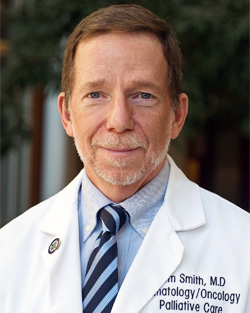
Harry J. Duffey Family Professor of Palliative Medicine and
Director of Palliative Medicine, Johns Hopkins Medical Institutions
Professor of Oncology, Sidney Kimmel Comprehensive Cancer Center
Training
University of Akron, B.S., summa cum laude 1971-74
Yale University School of Medicine, M.D. cum laude 1974-79
Yale University School of Organization and Management (core curriculum, one year) 1977-78
Special Visiting Fellow, National Cancer Center Biological Response Modifiers Program, Frederick, MD 1986
Virginia Commonwealth University Fellowship in Hematology/Oncology 1982-87
Project on Death in America Faculty Scholar, 1995-98
Current position
Professor of Oncology, Sidney Kimmel Comprehensive Cancer Center of Johns Hopkins, and the Harry J. Duffey Family Professor of Palliative Medicine, and Director of Palliative Medicine, Johns Hopkins Medical Institutions, Baltimore, MD
Dr. Smith is a medical oncologist and palliative care specialist with a lifelong interest in better symptom management, open and accurate communication, and improving access to high quality affordable care. He is the Director of Palliative Medicine for Johns Hopkins Medicine, charged with integrating palliative care into all the Johns Hopkins venues. The hospital wide PC consult service sees over 1500 patients a year, runs a 6-bed inpatient PC unit, and has a growing research agenda with “Scrambler Therapy” for pain, decision aids, integrated palliative care for patients on Phase I drug trials, and communication about serious illness.
Dr. Smith has a long track record of starting innovative programs with concurrent evaluation of their impact on care and costs, including the Virginia Rural Cancer Outreach Program, the Thomas Palliative Care Program, the Virginia Initiative on Palliative Care, and the Rural Palliative Care Program, among others. He attends on the Longcope Service of the Osler Medical Housestaff training program as well as in Palliative Care.
Dr. Smith received the national Humanism in Medicine Award in 2000, and in 2000 and 2006 was voted the Distinguished Clinician on the VCU-MCV Faculty. He has been recognized in “Best Doctors in America” for many years. He is a Fellow in the American College of Physician, the American Society of Clinical Oncology and the American Academy of Hospice and Palliative Medicine. In 2012 Bruce Hillner and he received the ABIM “Professionalism” Price for their NEJM article “Bending the Cost Curve in Cancer Care” and leading the “Choosing Wisely” initiatives for AAHPM and ASCO.
He is a 2010 ACS grantee to study the absorption of "ABH" gel as used for nausea; his other funded research includes an RO1 for a randomized trial of PC versus usual care for Phase I cancer patients, PC for pancreas cancer patients, patient-decision aids, and "scrambler" therapy for pain.
The Effectiveness and Cost-effectiveness of Palliative Care
Abstract
Background: Worldwide, medical treatment is becoming more intensive, complex, and expensive, with more use of the hospital and intensive care unit. In addition, the population is aging with more chronic illnesses and co-morbidities. People are also living longer with their diseases due to medical interventions, some of which are innovative and very expensive. All of these factors have made medical care a pressing economic problem for all countries. Palliative care has the potential to improve quality of life, improve quality of care, and reduce the cost of care.
Methods: Systematic review of the literature, economic and policy analysis.
Results: For any treatment to have an acceptable cost-effectiveness ratio, it must first be effective. There is no question that palliative care is effective. The available studies of palliative care strongly suggest acceptable cost-effectiveness, with substantial cost savings including 20 to 60% hospital cost savings for decedents who receive palliative care compared to those who do not (Smith T, et al. JPM 2003; Elsayem A, et al, JCO 2004). In New York State, hospitals with palliative care program saved over $5000 per admission (Morrison RS et al. Health Affairs 2011). Programs in Japan (Morita T, et al. Lancet Oncology 2013) and Germany report equal or better care at equal or lower cost (Gaertner J, et al. Health Policy 2013). Several randomized trials show equal or better care and $4500-7000 savings per person (Brumley R, et al. JAGS 2007; Gade G, et al. JPM 2008.) Lung cancer patients randomized to usual oncology care versus usual oncology care plus concurrent care demonstrated substantially improved quality of life, quality of care, better survival (Temel J, et al. NEJM 2010), and a cost saving of over $2000 per person. (Greer JA, et al. Proc ASCO 2012) Patients with multiple sclerosis who received palliative care had better clinical outcomes during and after the trial for up to 6 weeks and cost the UK National Health System £1,200 less than their peers who did not receive it (Currow DC, et al. JPM 2011; Higginson I, et al. Post Med J 2009). In every study to date, hospice and palliative care have been associated with equal or better survival and equal or lower cost (Hughes M, Smith TJ. Annual Rev Public Health 2014). Despite the compelling evidence, acceptance on the policy level is less than optimal. (Parikh RB, Kirch RA, Smith TJ, Temel JS. N Engl J Med. 2013)
Conclusions: The compelling reasons to do palliative care continue to be better symptom management, better advanced care planning and medically appropriate goal setting, and transitions to hospice care when appropriate. Other new-found compelling reasons include better survival with hospice and concurrent palliative care, and lower cost to hospitals and government and insurance funders. Acceptance of earlier and more widespread palliative care will be important for both clinical and economic reasons in the future.
